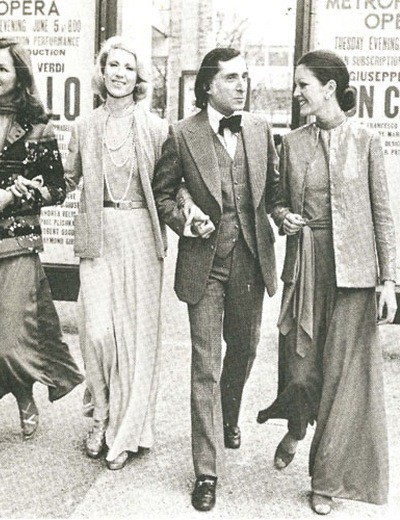
Herbert Kasper
About
Herbert Kasper has made his name as a designer by working predominantly for one company, Joan Leslie in New York, whom he joined in 1963. In 1980 he became vice president of the company as well as designer, creating high fashion looks that reflected trends but were commercial and wearable.
Herbert Kasper was born in New York, USA, in 1926. He studied English and advertising at New York University but left college prematurely to serve with the US Army in Europe. After military service in World War II, where he designed costumes for the troupe shows in which he took part as a chorus boy, Kasper enrolled at Parsons School of Design in New York. He then spent two years in Paris perfecting his skills, with a short period at l'École de la Chambre Syndicale de la Couture, Paris, and positions at Jacques Fath, Christian Dior and Marcel Rochas. Returning to the U.S., he worked for the milliner Mr. Fred, where his reputation grew. In his next position as dress designer for a company called Penart, Lord & Taylor in New York—which was promoting American designers—said they wanted to feature his work. Kasper's designs were then featured as Kasper of Penart. His talent was for making inexpensive clothes look exquisite and expensive, which endeared him to several other Seventh Avenue manufacturers in the 1950s.
Side by side, he contributed to Elle magazine. In the early 1960's, he returned to New York and started making clothes with his own label.
In 1963, he was awarded the prestigious Coty Award for American designers.
Joan Leslie (1902-1966) had a flourishing womens dress and sportswear comany in New York. When she died in 1966, the house called on Herbert Kasper to take over the design. He was subsequently made Vice President of the concern, which was known as Lesley Fay Co. Inc., where he remained till 1985.
In 1971 Kasper began a lower-priced line of casual separates called Kasper for J.L. Sport as well as his regular line for Joan Leslie. Part of his fashion philosophy has been that clothes should always work together, so he often found it difficult to differentiate between these two lines when designing. A coat for Joan Leslie Dresses, he once declared, could work equally well with the less expensive separates line for J.L. Sport. Kasper jackets were usually cardigans instead of blazers, his pants tended to be full and flowing. During the 1980's his designs included daytime and nightime dresses, as well as his modified versions of the popular bows, poufs and swags of fabric that were the signature of the decade.
The Look
Kasper is a designer who really cares about his customer. He wants the person who buys a dress to enjoy it and return for more. His satisfaction comes from seeing a woman look and feel good in his clothes. His reputation has always been that of a respectable craftsman who honors all levels of production involved in creating fashion, from design to manufacture. Kasper's clothes have always been associated with couture garments, at sportswear prices. He was a master at translating an expensive, tailored cut into a mass-market price tag. He excelled in knitwear, suede and silk garments. Most of his evening clothes have been covered up and restrained. A plain long dress might be enlivened by fabric woven with glistening threads or with a necklace embroidered around the neckline. Almost all of Kasper's short dresses ended just around the knee. While working in Paris, Kasper noted that women spent a great deal of money on custom-made clothes, ordering several outfits for different occasions. He formed a philosophy based on these observations that individual garments should be mixed and matched with many others to create several outfits, a sportswear concept that has become a way of life in the U.S. and elsewhere. Kasper has always been a great socialite. His social life inspired his work because it gave him an insight into how people live, their attitudes, and changing tastes. As a designer he is happy with his work, regarding each creation as one of his own children, which in a way justifies his devotion to his craft.